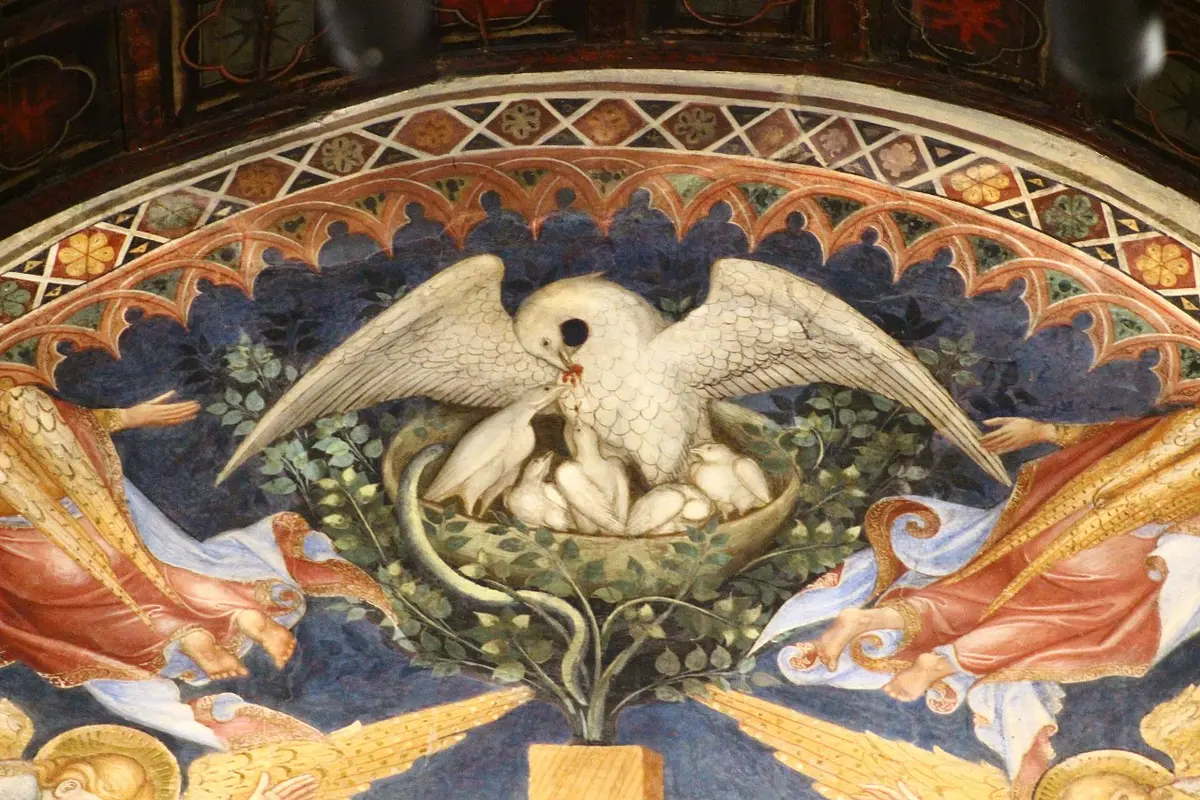















"As beautiful as a flower meadow in spring."
Salimbeni frescoes in the Oratory of St. John the Baptist



Where

What it is and where it is
As we walk nose-up along the little steps of San Giovanni, through the narrow streets in the heart of Urbino, we bliss at the sight of the Torricini of the Ducal Palace peeping through the rooftops and almost miss that modest wooden door surmounted by a rose window. But when we enter... A whirlwind of harnessed horses and soldiers in arms, lances and banners in the wind, and then women, children, bearded old men, sucks us toward the altar and that slender, soaring cross surrounded by weeping angels. We are standing before one of the greatest and most extraordinary works of florid Gothic art: the Crucifixion by the Salimbeni brothers. But that is not all.
Why it is special
As soon as we turn our gaze, there begins the story of the life of John the Baptist, unfolding placidly and imposingly across the entire left wall of the Oratory... Let's sit down. There is so much to see! Nine large panels translate the word of the Gospel into images for the poor people: Zechariah receiving the announcement from the archangel Gabriel and being punished by him with muteness for doubting; the meeting between Mary and Elizabeth; John's birth and circumcision; preaching; the baptism of Jesus and other believers in the fruitful waters of the Jordan... Here the story stops. It would be another painter, years later, who took it up again - but with a less refined hand - on another wall of the oratory and carried it through to the tragic denouement, with Salome asking for and obtaining John's head.
Not to be missed
The world that serves as a backdrop and surround for the sacred representations is extraordinary. Around the noblemen with curious headdresses and sumptuous robes, the weeping women gathered around Mary, the raging battle, indifferent to Christ's sacrifice, Nature invades every space with its infinite variety. Have you tried to count how many animals are painted on these walls? There's the pelican up there: high up in the center, a symbol of Jesus' sacrifice. And then horses, fish, dogs, birds, and even two fawns, a wolf and a hare that - together! - observe the scene hidden among the dense vegetation. Not least the scorpion and the green winged demon on the thief's cross. And have you noticed the variety of plants and flowers and leaves and the miniature care with which they are painted?
A bit of history
The Crucifixion and the Cycle of St. John, as well as the precious Madonnas on the left side of the Oratory were painted between 1416 and 1420 by the brothers Jacopo and Lorenzo Sal imbeni. The Salimbeni brothers are among the greatest protagonists of Italian "flamboyant Gothic," or International Gothic, the season that closed the Middle Ages and preceded the Renaissance. The Oratory of San Giovanni is very close to the birthplace of Raphael (1483-1520). It is easy to imagine him, as a child, praying in this Oratory, enchanting himself for hours before such wonder, finding in it inspiration and example.
Curiosities
Among the animals represented, a dog stands out (in fact, more than a dog!) and is somehow connected to meanings of purification: here he licks a child's face, there with his hind paw he scratches his muzzle heedless of the din of battle; in other scenes we catch him wiping his hindquarters thoroughly or sleeping under the bed of a parturient (considered unclean for 40 days after childbirth), while at the river he crouches over the cloths abandoned on the shore by their owners, now immersed in the water to receive baptism from John.
Enter the Map of Italy's Undiscovered Wonders and find treasures where you least expect it... Inspire, Recommend, Share...
Collections
The Map thanks:
In the Community
Enter the Map of Italy's Undiscovered Wonders and find treasures where you least expect it... Inspire, Recommend, Share...
Where

Collections

